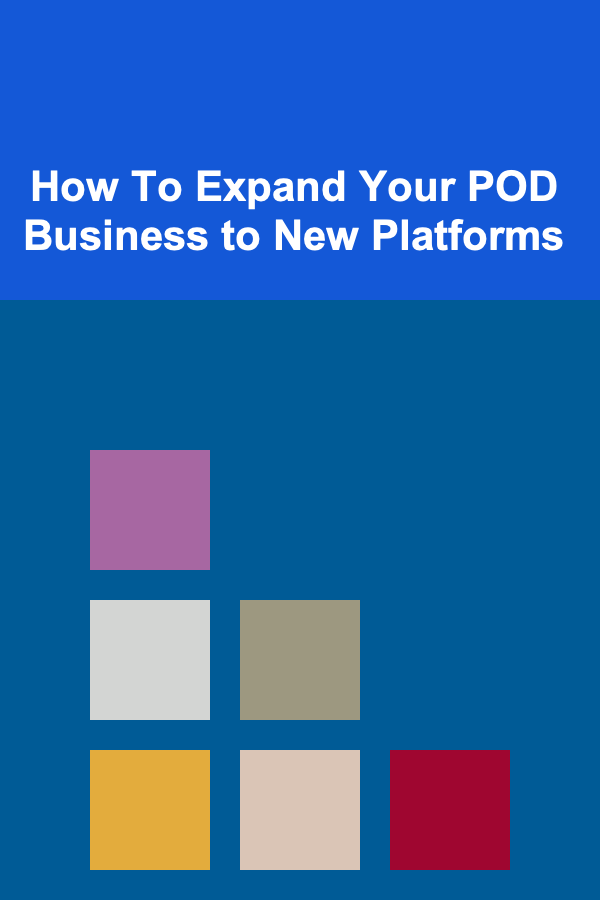
How To Expand Your POD Business to New Platforms
ebook include PDF & Audio bundle (Micro Guide)
$12.99$8.99
Limited Time Offer! Order within the next:

In the world of e-commerce, Print on Demand (POD) has emerged as one of the most flexible and lucrative business models. Entrepreneurs can design and sell custom products without the need to manage inventory, which minimizes risk and initial investment. The advent of platforms like Shopify, Etsy, and Amazon has allowed POD businesses to thrive by giving creators access to massive global audiences. However, as your POD business grows, the next step is to expand to new platforms to reach even more customers and diversify your revenue streams. Expanding to new platforms can unlock new opportunities, but it requires careful strategy and execution.
In this article, we'll dive deep into how to expand your POD business to new platforms. We'll explore why it's essential to expand, the platforms worth considering, and the key steps involved in making the transition successful. Whether you're currently selling on one marketplace or want to branch out to multiple channels, this guide will help you make informed decisions about scaling your POD business.
Why Expand Your POD Business to New Platforms?
Diversify Your Income Streams
Relying on a single platform for your business can be risky. While you may find success on one platform, factors like changes in algorithms, policy shifts, or competition can significantly impact your income. Expanding to new platforms mitigates this risk by diversifying your income sources. If one platform experiences a decline in traffic or sales, you'll still have other channels generating revenue.
Access to Different Customer Bases
Different platforms attract different types of customers. For example, Etsy is known for handmade and unique products, while Amazon has a broad audience that searches for everything from gadgets to fashion. By expanding to new platforms, you expose your POD products to various customer segments, increasing the likelihood of making sales. It's also important to note that customers on one platform may not be aware of your brand on another. Expanding increases your visibility and brand awareness.
Build a More Resilient Business
Business resilience is essential, especially in a volatile market. Relying solely on one platform for sales can be a huge disadvantage. Expanding your POD business to multiple platforms allows you to capitalize on the strengths of each. For instance, if your Shopify store is doing well, but your Amazon listing isn't as strong, diversifying can buffer you from unexpected disruptions.
Improve Brand Recognition
Being present on multiple platforms boosts brand recognition. If customers see your business in various places, they become more familiar with your brand. The more touchpoints you have with your audience, the higher the chances that they will become repeat buyers. This is especially valuable if you are trying to build a recognizable brand identity in a competitive market.
Increase Potential for Global Reach
Platforms like Redbubble, Teespring, or Society6 offer access to international markets. Many POD entrepreneurs limit themselves to the regional market, but by expanding globally, you can significantly increase the potential customer base. Different platforms have varying reach and popularity in different countries, and targeting international markets can open new doors for growth.
Which Platforms Should You Consider?
Expanding to new platforms requires careful selection to ensure compatibility with your business model. Not all platforms are equal, and each has its strengths and weaknesses. Here's an overview of some of the most popular platforms for POD businesses:
1. Shopify
Shopify is one of the most popular e-commerce platforms for POD businesses. It's a great option for entrepreneurs who want more control over their branding and customer experience. Shopify allows you to set up a custom store and integrate with various POD services like Printful, Printify, and Teespring.
- Pros: High level of customization, own domain and branding, ability to control customer experience.
- Cons: Monthly subscription fees, requires more setup and maintenance.
2. Etsy
Etsy is a marketplace known for handmade, vintage, and unique products. It's an excellent platform for POD businesses that create custom, artistic, or personalized products. Etsy attracts a niche audience looking for unique gifts, home decor, and more.
- Pros: Large audience of buyers looking for custom items, built-in customer base, minimal startup cost.
- Cons: Marketplace fees, high competition, strict policies on product listings.
3. Amazon
Amazon is one of the largest e-commerce platforms globally. With millions of customers, it offers a massive audience for your POD business. You can sell your POD products through Amazon's Merch by Amazon program or Amazon FBA.
- Pros: Massive customer base, high traffic, international reach.
- Cons: Increased competition, stricter guidelines for listings, fees for certain selling programs.
4. Redbubble
Redbubble is a marketplace specifically tailored for POD sellers. It allows creators to upload their designs, which can then be printed on a wide range of products like t-shirts, posters, and phone cases. Redbubble handles the production, shipping, and customer service.
- Pros: No upfront costs, global reach, user-friendly interface.
- Cons: Less control over branding, lower profit margins, reliance on platform algorithms.
5. Teespring
Teespring allows creators to design and sell custom products like t-shirts, mugs, and hoodies. It offers an easy-to-use platform where you can set up your store and sell your products without upfront costs.
- Pros: No upfront costs, simple integration, good for creating and marketing POD products.
- Cons: Limited control over customization, low profit margins, platform fees.
6. Society6
Society6 is a platform for artists who want to sell their designs on various products, such as home decor, furniture, and accessories. It's a great platform for more artistic or niche POD businesses.
- Pros: Good for high-quality, artistic products, handles production and fulfillment.
- Cons: Limited customization options, lower margins due to high fees.
7. WooCommerce
WooCommerce is a WordPress plugin that turns your site into an e-commerce store. It's a good option for POD entrepreneurs who want more control over their store and sales process, similar to Shopify.
- Pros: Customization, no subscription fees, full control over branding.
- Cons: Requires technical knowledge, hosting and domain costs, additional setup required.
8. Zazzle
Zazzle is another popular POD platform that allows you to upload your designs to be printed on a variety of products. It has a broad customer base, including buyers looking for gifts and custom merchandise.
- Pros: Wide range of products to print on, easy-to-use platform, no upfront costs.
- Cons: Low profit margins, high competition, limited control over the customer experience.
Key Steps to Expanding Your POD Business
Expanding to new platforms requires careful planning and execution. Here's a step-by-step guide to making a successful transition:
1. Evaluate Your Current Success
Before expanding, evaluate the performance of your current platform(s). Ask yourself questions like:
- Are you consistently making sales?
- Which products are the most popular?
- What's your average profit margin?
- Do you have a solid brand presence?
Understanding where you are will give you insights into which platforms will be a good fit for your business and help you avoid jumping into expansion prematurely.
2. Research the Platforms
Take time to research the platforms you're considering expanding to. Look at the types of products that do well on each platform, the level of competition, the fees associated with selling, and the target audience. It's crucial to understand how each platform works, how they attract customers, and the best practices for selling.
3. Optimize Your Product Listings
Different platforms have different requirements and best practices for product listings. Tailor your product descriptions, keywords, and images to match the platform's audience and guidelines. High-quality photos, detailed descriptions, and accurate tags can make a significant difference in how your products perform.
4. Start with One Platform at a Time
Rather than overwhelming yourself with multiple platforms at once, start by expanding to one platform. For example, if you're successful on Etsy, consider branching out to Shopify. Master the new platform before adding more. Managing multiple platforms at once can be time-consuming and difficult, especially when you're just starting.
5. Cross-Promote Your Products
Once your products are live on the new platform, cross-promote them on your existing channels. Use social media, email marketing, and your website to let your customers know you're expanding. Cross-promotion can help drive traffic to your new listings and increase sales from existing customers.
6. Monitor and Optimize
After expanding to a new platform, closely monitor your performance. Track which products are selling, your conversion rates, and customer feedback. Use this data to optimize your listings, tweak your marketing strategy, and adjust your pricing if necessary.
7. Leverage Ads and Promotions
Once you have a presence on a new platform, consider running ads or promotions to drive traffic to your listings. Many platforms, like Etsy, Amazon, and Facebook, offer paid advertising that can boost your visibility and sales.
Conclusion
Expanding your POD business to new platforms can open up new revenue streams, increase brand visibility, and diversify your customer base. However, it requires thoughtful planning and a strategic approach. By evaluating your current success, researching potential platforms, and carefully managing your expansion process, you can take your POD business to new heights.
Remember, each platform is unique, and understanding the strengths and weaknesses of each is key to ensuring a successful expansion. With the right approach, expanding your POD business can lead to long-term growth and success in the competitive world of e-commerce.

How to Create a Personalized Home Office Setup
Read More
How to Develop a Checklist for Goal Setting and Time Management
Read More
How to Stage Your Home When You Have a Tight Budget
Read More
How to Steam Shellfish: A Comprehensive Guide
Read More
How to Buy and Sell Crypto Safely
Read More
Mastering Delegation for Busy Leaders: A Comprehensive Guide
Read MoreOther Products

How to Create a Personalized Home Office Setup
Read More
How to Develop a Checklist for Goal Setting and Time Management
Read More
How to Stage Your Home When You Have a Tight Budget
Read More
How to Steam Shellfish: A Comprehensive Guide
Read More
How to Buy and Sell Crypto Safely
Read More